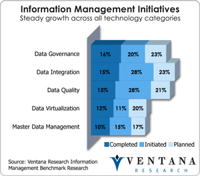One of the community groups to which I donate my time is an organization that puts on a Concours d’Élegance – a vintage car show. Such Concours date back to seventeenth-century France, when wealthy aristocrats gathered to see who had the best carriages and most beaudacious horses. Our Concours serves as the centerpiece to a broader mission of raising money for several charities. There a many such events in the United States and elsewhere, but this one, which has been held every year since 1956,...
Read More
Topics:
Big Data,
GRC,
Operational Performance Management (OPM),
Business Analytics,
Business Intelligence,
CIO,
Operational Intelligence,
Business Performance Management (BPM),
CFO,
finance,
Financial Performance Management (FPM),
Information Management (IM),
IT Performance Management (ITPM),
Talent Management,
FPM
Our research consistently finds that defects in data are the root cause of a wide range of problems encountered by modern corporations. The magnitude of the problem correlates with the size of the company: Big companies have bigger headaches than midsize ones. Data issues diminish productivity in every part of a business as people struggle to correct errors or find workarounds. Issues with data are a man-made phenomenon, yet companies seem to treat bad data as some sort of force of nature like...
Read More
Topics:
Big Data,
Predictive Analytics,
GRC,
Operational Performance Management (OPM),
Business Analytics,
Business Intelligence,
CIO,
Operational Intelligence,
Business Performance Management (BPM),
CFO,
Customer Performance Management (CPM),
finance,
Financial Performance Management (FPM),
Information Management (IM),
IT Performance Management (ITPM),
Sales Performance Management (SPM),
Supply Chain Performance Management (SCPM),
Workforce Performance Management (WPM),
FPM
Midsize businesses “pay” for their use of entry-level accounting systems by not having the essential information they need readily available and by using up valuable time that could be better spent generating business, finding issues or responding to opportunities sooner or simply enhancing the efficiency of the organization. Nevertheless, the transition from an entry-level accounting package such as QuickBooks to an on-premises system can be daunting for companies whose entry-level software no...
Read More
Topics:
Customer Experience,
ERP,
Office of Finance,
end-to-end,
finance cloud,
Cloud Computing,
Business Performance Management (BPM),
Business Process Management,
CFO,
finance,
Financial Performance Management (FPM),
Sales Performance Management (SPM),
accounting software,
business process execution,
financial systems,
FPM
For the past several years Ventana Research has focused more on analytics and their importance to improving business performance. We’ve done extensive benchmark research in business analytics, detailing how they are used generally in business and in major functional areas of companies as well as their application in specific industries. We adopted this focus because technology advances are changing the landscape of analytics. Its use in business management, for example, is getting new scrutiny...
Read More
Topics:
Big Data,
Performance Management,
Planning,
Human Capital Management,
Modeling,
Office of Finance,
Operational Performance Management (OPM),
Budgeting,
driver-based,
Analytics,
Business Analytics,
In-memory,
Business Performance Management (BPM),
Customer Performance Management (CPM),
Financial Performance Management (FPM),
Sales Performance Management (SPM),
Supply Chain Performance Management (SCPM),
Workforce Performance Management (WPM),
best pracices,
business value,
cash management,
challenge,
financial planning
People used to use the phrase “the last mile” solely to refer to a condemned prisoner’s path to execution. Then the telecommunications industry picked it up to describe that part of a circuit between a major trunk line and a subscriber. Later still a defunct software company, Movaris (now part of Trintech), used the phrase in an analogy to refer to the set of activities that take place between when a company closes its books and the point where it finishes its external reporting activities,...
Read More
Topics:
Customer Experience,
Governance,
GRC,
Office of Finance,
Reporting,
audit,
close,
Consolidation,
Controller,
XBRL,
Governance, Risk & Compliance (GRC),
Business Performance Management (BPM),
CFO,
compliance,
Financial Performance Management (FPM),
FPM,
SEC
What does it cost to run an IT department? That’s an easy question to answer, but for most companies, why it costs that amount is not. IT departments often complain that most of their budget is devoted to funding daily operations and basic maintenance (“keeping the lights on”), but often, one big overlooked problem is the chargeback process that most companies use to assign IT department operating costs.
Read More
Topics:
Sales,
Office of Finance,
Operational Performance Management (OPM),
Budgeting,
chargebacks,
Business Intelligence,
Business Performance Management (BPM),
Financial Performance Management (FPM),
IT cost
For several years the U.S. Securities and Exchange Commission (SEC) has mandated that filers apply eXtensible Business Reporting Language (XBRL) tags to their financial statements. XBRL was developed to make it easier for investors to use a company’s financial information. Now XBRL US has kicked off its second annual XBRL Challenge, a contest designed to encourage development of open source analytical tools that can use XBRL-formatted corporate financial data from the SEC’s EDGAR database....
Read More
Topics:
Office of Finance,
Reporting,
closing,
XBRL,
Analytics,
Business Analytics,
Business Performance Management (BPM),
finance,
Financial Performance Management (FPM),
Information Management (IM),
Financial Performance Management,
SEC











